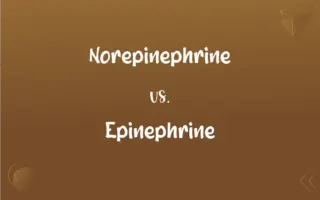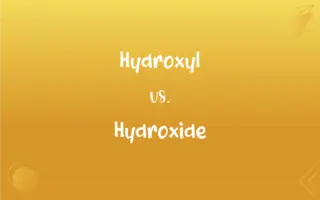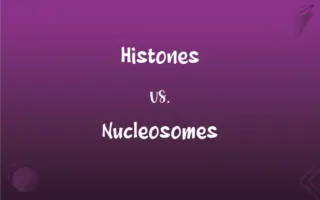Oxazole vs. Isoxazole: What's the Difference?
Edited by Aimie Carlson || By Harlon Moss || Published on May 4, 2024
Oxazole is a heterocyclic compound with a nitrogen and an oxygen atom in a five-membered ring; isoxazole has the oxygen and nitrogen atoms adjacent to each other.

Key Differences
Oxazole is characterized by a five-membered ring containing both nitrogen and oxygen atoms, with the oxygen atom positioned at the first carbon (C1) and the nitrogen atom at the third carbon (C3) of the ring. Isoxazole, on the other hand, also features a five-membered ring but differs in the positioning of the oxygen and nitrogen atoms, which are adjacent to each other, with the oxygen at the first carbon (C1) and the nitrogen at the second carbon (C2). This structural variation significantly influences the chemical properties and reactivity of these compounds.
The chemistry of oxazole includes its role in organic synthesis and its presence in various biologically active molecules, indicating its importance in pharmaceuticals and agrochemicals. Isoxazole is notable for its utility in the synthesis of a wide range of compounds, including drugs and polymers, where its distinct reactivity due to the adjacent oxygen and nitrogen atoms is leveraged. The unique positioning of these heteroatoms in isoxazole compared to oxazole affects its electronic configuration and, consequently, its participation in chemical reactions.
Oxazole compounds are known for their aromaticity, which stabilizes the ring structure and influences their interaction with other molecules. The aromatic nature of oxazole and isoxazole contributes to their inclusion in various natural products and synthetic materials. However, the different positions of nitrogen and oxygen in these rings lead to distinct electronic distributions, affecting their ability to participate in hydrogen bonding and other intermolecular interactions. This impacts their solubility, boiling points, and overall reactivity.
In the context of drug design and medicinal chemistry, oxazoles are often explored for their potential as pharmacophores, the part of a molecule responsible for its biological activity. Similarly, isoxazoles have been incorporated into the structure of various drugs, exploiting their unique reactivity for the creation of compounds with desired therapeutic effects. The difference in the positioning of heteroatoms in oxazole and isoxazole rings enables them to fit into different biological targets, highlighting the significance of their structural distinction in biomedical applications.
Understanding the distinctions between oxazole and isoxazole is crucial for chemists and researchers working in the fields of synthetic organic chemistry, pharmaceuticals, and material science. The structural variations between these two compounds underscore the diversity of heterocyclic chemistry and its importance in the development of new materials, drugs, and advanced chemical synthesis strategies. Their different properties and reactivities reflect the broader principle that small changes in molecular structure can lead to significant differences in chemical behavior and applications.
ADVERTISEMENT
Comparison Chart
Position of Heteroatoms
Oxygen at C1, Nitrogen at C3
Oxygen at C1, Nitrogen at C2
Chemical Reactivity
Different due to heteroatom spacing
Unique adjacent heteroatom reactivity
Biological Activity
Varied, depending on substitution patterns
Influenced by nitrogen-oxygen adjacency
Usage in Synthesis
Used in diverse organic synthesis
Preferred for specific synthetic applications
Electronic Configuration
Affected by non-adjacent heteroatoms
Altered by adjacent heteroatoms
ADVERTISEMENT
Oxazole and Isoxazole Definitions
Oxazole
Oxazoles are key intermediates in organic synthesis.
We synthesized a series of oxazole derivatives as part of our research.
Isoxazole
The compound's reactivity is influenced by its nitrogen-oxygen adjacency.
The isoxazole core was functionalized to obtain novel materials.
Oxazole
Oxazole is a heterocyclic compound with aromatic properties.
Oxazole rings are common in many biologically active molecules.
Isoxazole
Isoxazole is a nitrogen and oxygen-containing heterocycle.
Isoxazole derivatives show promise in drug development.
Oxazole
It contains one nitrogen and one oxygen atom in a five-membered ring.
The oxazole structure contributes to the molecule's stability and reactivity.
Isoxazole
Isoxazoles are utilized in the synthesis of diverse organic compounds.
Isoxazole rings serve as precursors in advanced organic synthesis.
Oxazole
Its aromatic nature influences its chemical behavior.
The aromaticity of oxazole makes it a component in various pharmaceuticals.
Isoxazole
It features adjacent oxygen and nitrogen atoms in its structure.
The unique positioning in isoxazole affects its electronic properties.
Oxazole
Oxazole compounds are explored for their pharmacological potential.
The oxazole moiety was crucial for the drug's mechanism of action.
Isoxazole
Isoxazoles play a role in the discovery of new therapeutic agents.
An isoxazole compound was identified as a potent anti-inflammatory agent.
Oxazole
(organic compound) A five-membered heterocycle having three carbon atoms, one oxygen atom, one nitrogen atom and two double bonds; the 1,3- isomer is aromatic
Isoxazole
(organic compound) 1,2-oxazole, an isomer of oxazole with many derivatives that have pharmacological activity.
FAQs
What defines isoxazole?
A heterocyclic compound with adjacent oxygen and nitrogen atoms in a five-membered ring.
What is oxazole?
A five-membered aromatic heterocycle with one oxygen and one nitrogen atom.
Why are isoxazoles important in drug discovery?
Due to their unique reactivity and potential for creating compounds with therapeutic effects.
What makes oxazole compounds significant in chemistry?
Their stability, aromatic nature, and presence in biologically active molecules.
What is the impact of heteroatom positioning in oxazoles and isoxazoles?
It influences their electronic distribution, chemical reactivity, and biological activity.
How are oxazoles synthesized?
Through various organic synthesis methods, including cyclization reactions.
What are the typical uses of isoxazoles in organic synthesis?
As precursors in the synthesis of polymers, pharmaceuticals, and agrochemicals.
How do oxazole and isoxazole differ structurally?
Their difference lies in the positioning of the oxygen and nitrogen atoms within the ring.
How does the nitrogen-oxygen adjacency in isoxazoles affect its properties?
It alters electronic configuration, enhancing reactivity and interaction with biological targets.
What role do oxazoles play in pharmaceuticals?
They are incorporated into drugs for their unique properties and biological activity.
How do oxazole and isoxazole compare in terms of biological activity?
Both offer diverse biological activities, influenced by their structure and substituents.
Can isoxazole compounds act as pharmacophores?
Yes, their structure can be essential for the biological activity of certain drugs.
Can oxazole and isoxazole be found in nature?
Yes, both are present in various natural products and bioactive compounds.
How do researchers determine the best use of oxazoles and isoxazoles?
Through extensive chemical and biological testing to explore their properties and applications.
Do oxazoles and isoxazoles share similar reactivity?
Their reactivity differs due to the distinct spacing and orientation of heteroatoms.
Are oxazole derivatives widely used in material science?
Yes, for their aromatic stability and ability to participate in various chemical reactions.
What challenges exist in synthesizing isoxazole compounds?
Controlling reactivity and selectivity due to the proximity of nitrogen and oxygen atoms.
What advancements have been made in oxazole chemistry?
Developments include new synthesis methods and applications in drug design.
Are there specific environmental applications for isoxazoles?
Isoxazoles are explored for their potential in producing eco-friendly materials and chemicals.
What future research directions are there for oxazole and isoxazole compounds?
Investigating new synthetic pathways, enhancing biological activity, and developing novel applications in various fields.
About Author
Written by
Harlon MossHarlon is a seasoned quality moderator and accomplished content writer for Difference Wiki. An alumnus of the prestigious University of California, he earned his degree in Computer Science. Leveraging his academic background, Harlon brings a meticulous and informed perspective to his work, ensuring content accuracy and excellence.
Edited by
Aimie CarlsonAimie Carlson, holding a master's degree in English literature, is a fervent English language enthusiast. She lends her writing talents to Difference Wiki, a prominent website that specializes in comparisons, offering readers insightful analyses that both captivate and inform.









































































